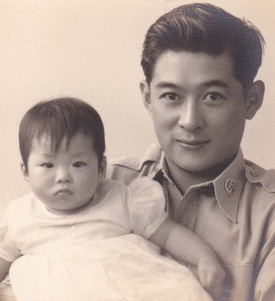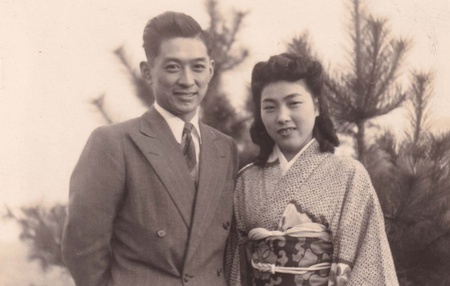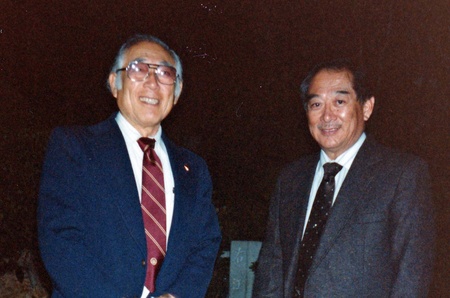I left Los Angeles over a half decade earlier in 2010 and had not been back since. A visit to see my sister in downtown Los Angeles’s Little Tokyo prompted my return in 2018, allowing me to take care of some minor matters and visit some old haunts. While she was away at work one day, I took the opportunity to visit the Japanese American National Museum (JANM) and mark another item off my trip checklist.
The summer day’s short walk from her home to the Museum reminded me how much Nihonmachi had changed since my childhood. Years of economic slide and Skid Row’s encroachment in the late 1960s and 70s gave way to the inflated “Japan as Number One” bubble economy influences in the 1980s. That bubble’s bursting caused many of Little Tokyo’s businesses to close in the 1990s. Vacant storefronts became commonplace as Japanese corporations started to abandon Southern California. And now, economic activity had once again returned as the rising townhomes and condos stood tall against the sunny sky where once flat asphalt parking lots baked in summer’s heat.
Long gone were the Far East Café’s flavors of my childhood. My fading Atomic Café memories were demolished to build a new light rail station. The Los Angeles Police Department’s Parker Center disappearance pleased many Angelenos. Gone, too, were my other sister Shirley; my cousin Linda; and both her parents, my Utako-obachan and my uncle Hitoshi, who went by his nickname “Sto.” They and many others had all passed away.

Despite the passage of time, some cherished long-time Little Tokyo icons persisted: Suehiro, Anzen Hardware, Bunkado, Mitsuru Café, Kouraku, Fugetsu-do, Kinokuniya, the multiple Buddhist temples and Christian churches. But things do change. Rinban Ito from Higashi Honganji Buddhist Temple might remind me about the impermanence of all things. He, too, is a cherished Little Tokyo icon.
I waited for a green light to cross East 1st Street towards the JANM Plaza and gazed left towards the Go For Broke National Education Center (GFBNEC) that now occupied the small original JANM building. The lovingly restored entryway architecture from the old Nishi Hongwanji Temple now looked welcoming. It was a far cry from its ghostly appearance after the temple moved in the late 1960s, leaving behind the building vacant and looking abandoned. As the green light signaled my right of way to cross the intersection, I recalled that Uncle Sto volunteered at both JANM and the GFBNEC.
I entered the plaza, paused, and stood for a moment to remember. I wondered, does the original plaque of Issei honorees acknowledging the Museum’s charter donations still exist in that original JANM building? My father, Osamu, had donated to help establish it, too. Were his Issei parents’ names, those of my grandparents, Seisuke and Tome, still listed there? That was nearly a quarter century ago. Maybe not. Things change. Especially in Los Angeles.
I turned right, climbed the stairs, and entered JANM’s modern pavilion building. As the front desk staff handled my admission, I placed the entry sticker on my shirt and asked an associate, “Is the plaque of Issei honorees still in the original JANM Building? If it is, can I view it?”
“It’s probably still there. You can ask to see if it is,” she replied. “Your JANM admission today admits you to see the Go For Broke National Education Center, too. Just ask them if it’s still there and they’ll show you.”
“Great! Thank you,” I replied. “I’ll be right back after I take a look.”
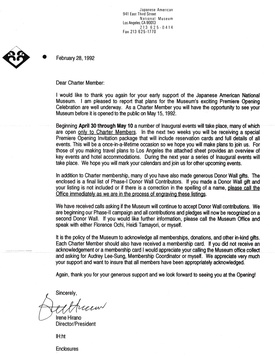
I first saw the large plaques at a reception for charter members and donors in the early 1990s. Dad took our family to a reception in celebration of the Museum’s opening. Happiness filled the semi-formal affair. The Sameshima family attended the event, too, with Uncle Sto, Utako Obachan, and my cousin Linda present. A few speeches with lots of cheerful conversation, jokes, and laughter made it feel more like a reunion, rather than the culmination of years of hard work after decades of hardship and suffering. As people occasionally paused, looked up in silence, and read the names, you could see their hearts filled with the conflicting simultaneous emotions of sadness, joy, and gratitude.
Dad wept when he received his letter of apology from President George H. W. Bush and his $20,000 reparations check from the Civil Liberties Act of 1988. I had never seen him weep before. He told me that it says a lot about this country, that it apologized for the harm it had caused. He also said a simple apology, though, was not enough. It was important that the government paid for damages, too, so they learned not to do it again.
Dad offered more than half of his reparations check to his children. None of us wanted it. He was the one who paid the price. Not us. So, Dad made us an offer. We could accept our portions from his reparations check and in turn donate those amounts to JANM. He too would include his portion, and together our combined donations would honor his Issei parents, our grandparents Seisuke and Tome. I know he felt extremely sad they didn’t live to see the day when the US Government apologized for its crimes committed against them. We felt the same. Remembering our grandparents’ sacrifice was part of our way to help honor them.
Thereafter, Dad became more willing to talk about his wartime experience. I never wanted to push him, but I wanted to hear firsthand his story of what I had learned at Pasadena City College and UCLA in Asian American Studies classes. I listened to whatever he was willing to share. Carefully, over time, I asked questions. He answered them.
I read about and researched his difficult case. I visited the Hirasaki National Research Center to study the historical context and background, and to piece together our family’s history. I watched Dad’s sister’s, my Aunt Toyo’s, video oral history in the JANM Collection at Densho.1 I learned about their life before the war in Gardena, California; their detention at Santa Anita; and incarceration at Jerome. I read about their US citizenship renunciations; their segregation at Tule Lake; their affiliation with the Hokoku Hoshi-dan groups2; Dad’s and Ojiichan’s internment at Ft. Lincoln and Santa Fe; their deportation to Japan after the war; and Dad’s resulting statelessness. I learned about Wayne M. Collins and the Tule Lake Defense Committee’s work to cancel the family’s renunciations; US District Court Judge, Louis E. Goodman’s favorable ruling in Abo v. Clark; Dad’s US Air Force enlistment and service during the 1950s; and about his honorable discharge and return to Los Angeles.
During those same years I also learned more about Uncle Sto’s experiences, about his family stories firsthand, and his military experiences from his recorded GFBNEC oral history. I learned about Uncle Sto growing up in Pasadena, California; his expulsion from the University of Southern California because of Pearl Harbor; his detention at Santa Anita; incarceration at Gila River; educational leave to the University of Denver; his US Army draft; Military Intelligence Service involvement; translation work at the Tokyo War Crimes Trials; his unit’s Congressional Gold Medal award; and most importantly how Uncle Sto met my Aunty Utako and got married, and how that connection led to my parents’ courtship and marriage.

I learned a lot. Especially how astonishingly unique Dad’s and Uncle Sto’s lifelong camaraderie and friendship got established and never suffered the decades long and seemingly irreparable tear between the so-called “loyals” and “disloyals,” which ripped apart the Japanese American community.
They, and all my elders, taught me a lot. I just had to listen.
In the 1990s, when JANM offered to inscribe Nisei honorees’ names for contributions to help complete the new Pavilion, my siblings and I donated on behalf of our parents. My cousin Linda did the same on behalf of her parents Hitoshi and Utako. The years were rapidly passing. It was time to honor our parents. JANM held another celebratory reception, and although my parents could not attend that event, my siblings and I participated along with the Sameshima family. Now to honor the Nisei, our parents’ names joined all those inscribed on the clear glass windows of the sunlight-filled Aratani Central Hall. Included among the names were:
OSAMU OKUMURA YOSHIKO OKUMURA
HITOSHI SAMESHIMA UTAKO SAMESHIMA
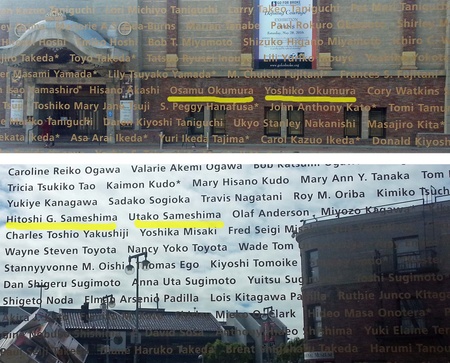
That was over a decade and a half ago. Now, as I entered the original JANM building auditorium in search of the plaques of Issei honorees, my eyes slowly adjusted to the dimness. This was the same room where we celebrated the Museum’s opening and honored our Issei ancestors over 25 years earlier. In the low light, I negotiated the hastily closed folding chairs and tables laid about the room and against the walls. It appeared the auditorium hadn’t been used in quite some time. Perhaps the plaques had been removed. Who even remembered they were there? As my eyes further adapted to the soft light, the space became calm and reverent. It felt like the glowingly ambient candlelit interior of an old Japanese Buddhist temple hondo. No surprise, I figured. It was exactly that from around ninety years ago.
I looked up towards the tall ceilings. High on the walls above the room’s entrances were the Issei honorees’ names. The golden plaques radiated warmly in the gentle light. I searched and found our Issei ancestors’ names still watching over us. Included among them were:
SEISUKE & TOME OKUMURA
CHOSABURO & TSUNA SAMESHIMA
I could sense their presence reassuringly anchoring me. The Issei spirits felt welcoming, encouraging, and they advised me, がんばれ!よく探せば絶対に仕方がある。よく覚えて、忘れないで。 I placed my hands together in gassho and expressed my gratitude to them and all those who came and went before me.
As I walked across the plaza back towards the pavilion to continue my Museum visit, I vowed to live up to our Issei ancestors’ instilled words of advice to me, “Give it your best. Search carefully, there’s always a way forward. Remember well and never forget.”

Notes:
1. See the Toyoko Okumura Oral History (recorded July 6, 2008) at densho.org.
2. These groups originated in 1944 at Tule Lake out of the Resegregation Movement. For more information, see part 4 of “Legalizing Detention: Segregated Japanese Americans and the Justice Department’s Renunciation Program” by Barbara Takei at discovernikkei.org.
*Author's note: Kansha (感謝, gratitude) to Robin Elder, Yoko Nishimura, Janet Otsuki, Elizabeth Fenwick, Nora Goodfriend, Robin White, and Carol Sweig for their guidance; and especially to JANM and all those who taught me about the Nikkei experience
(All photos courtesy of the author)
© 2023 James Okumura



